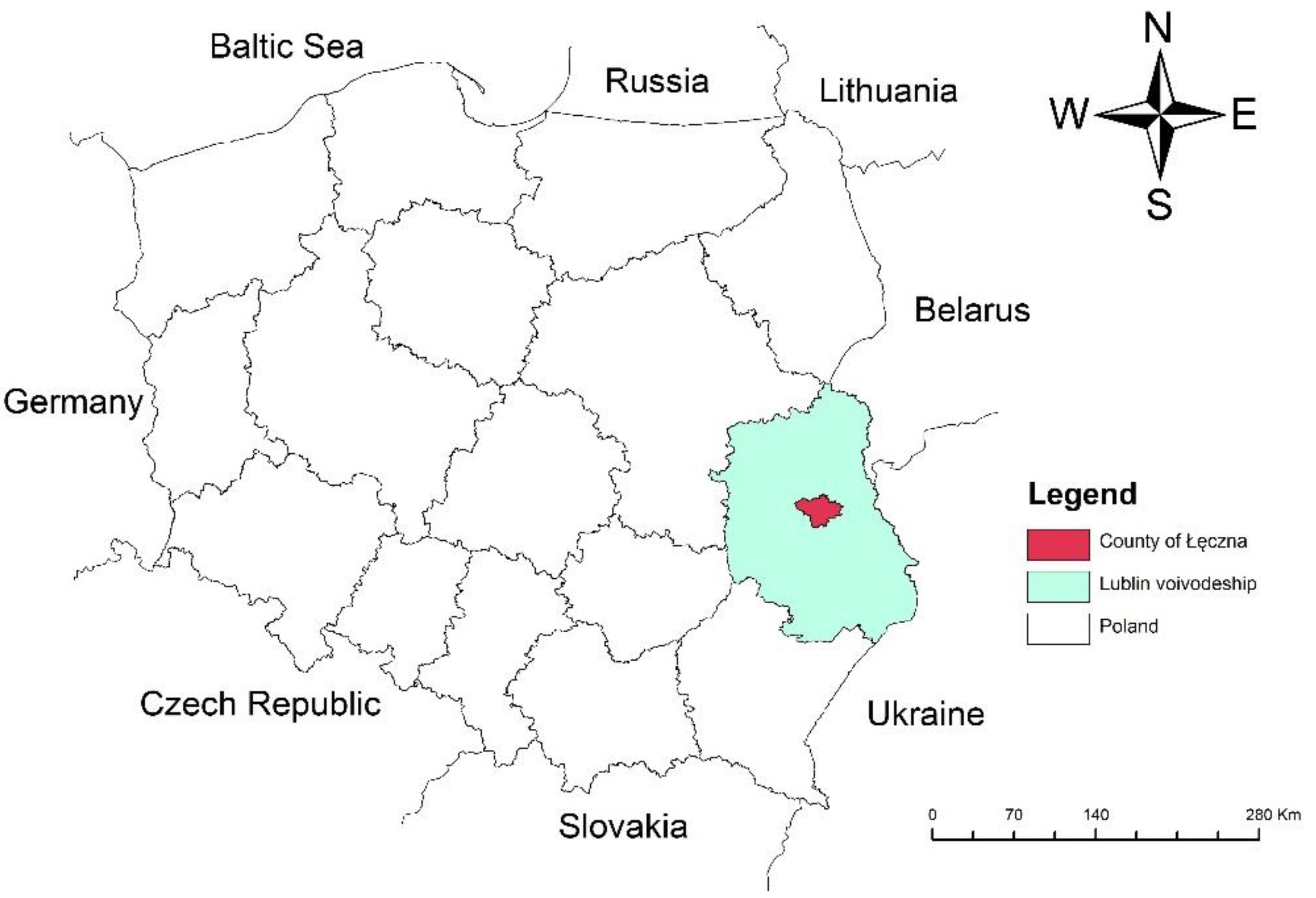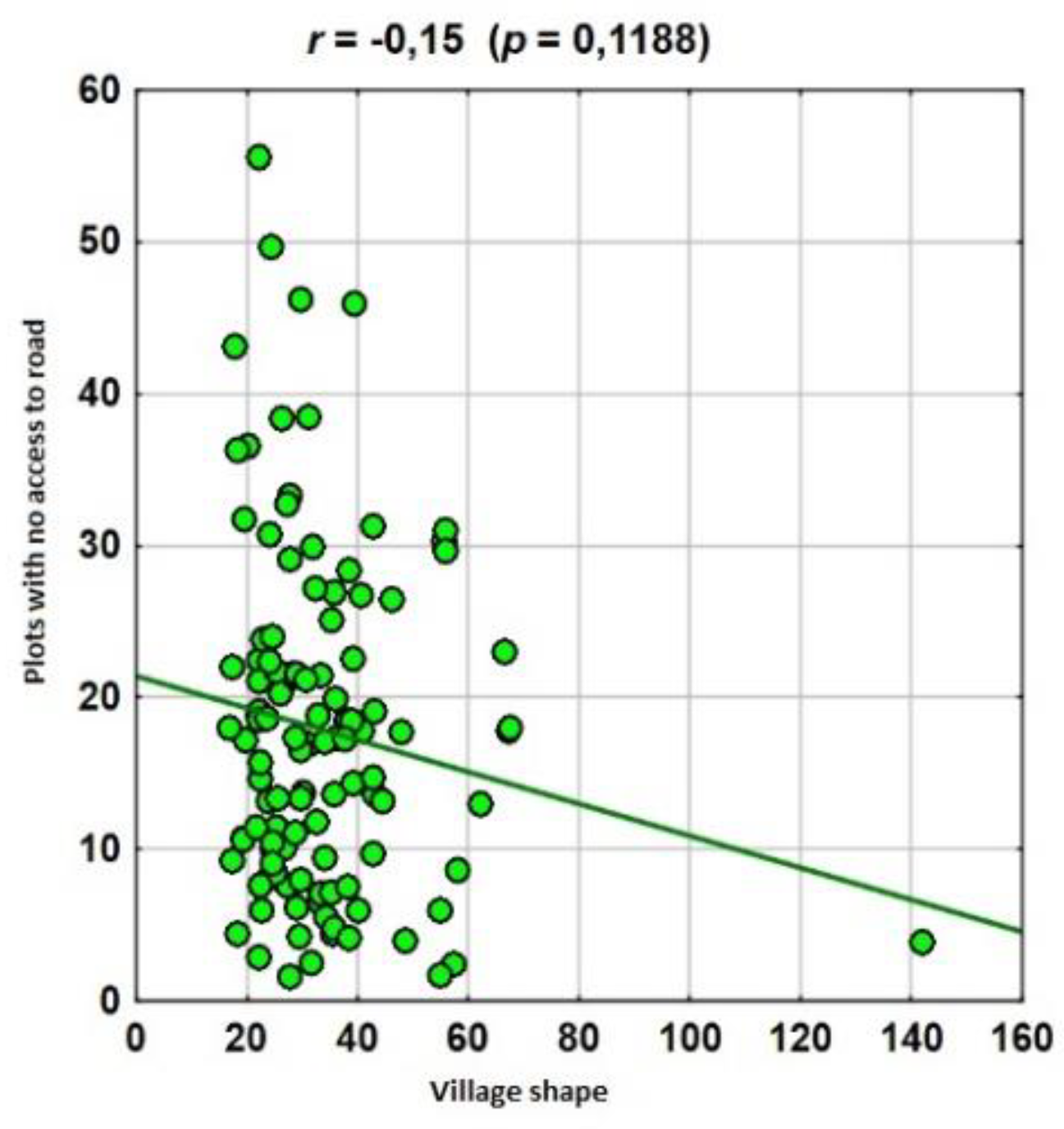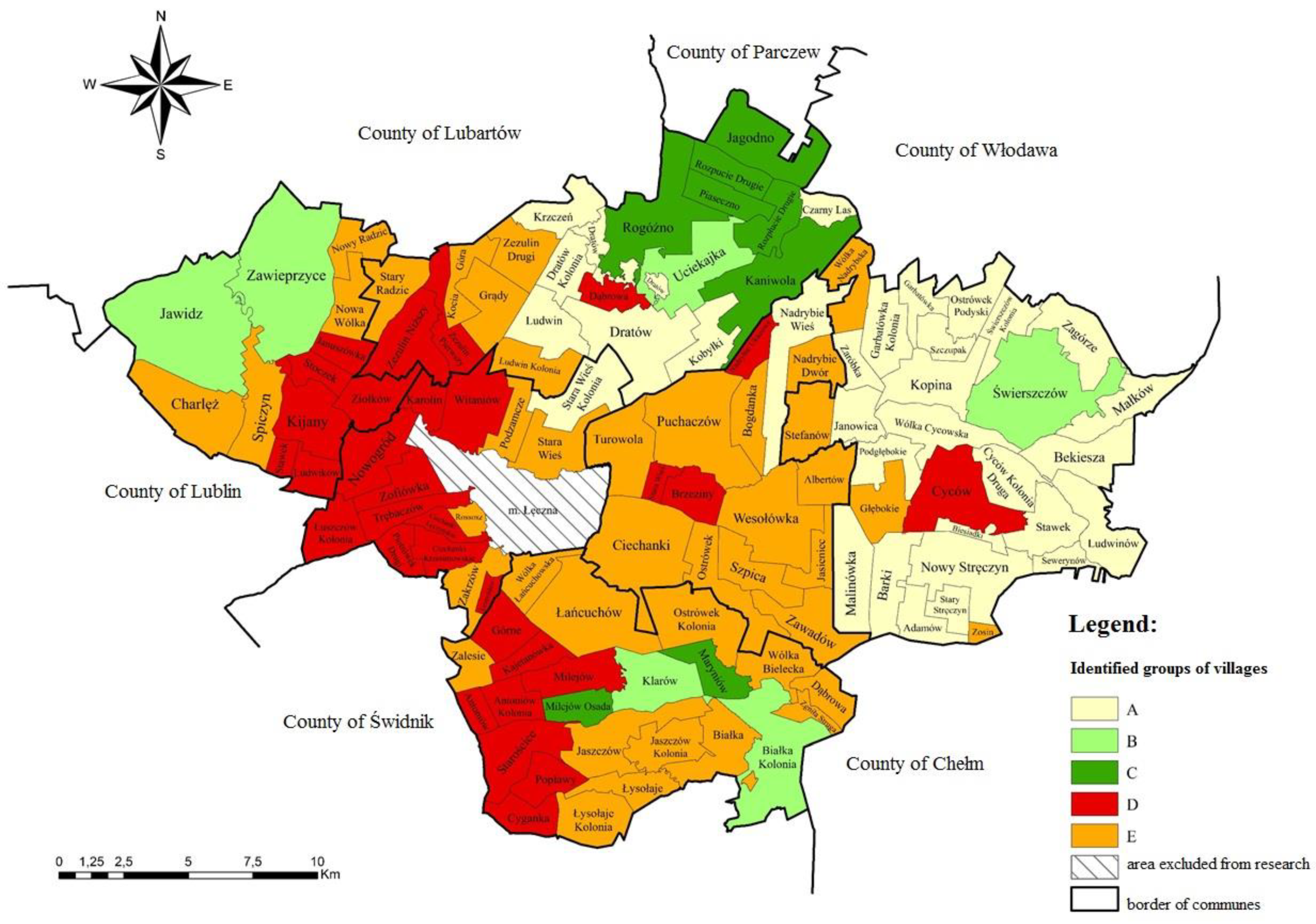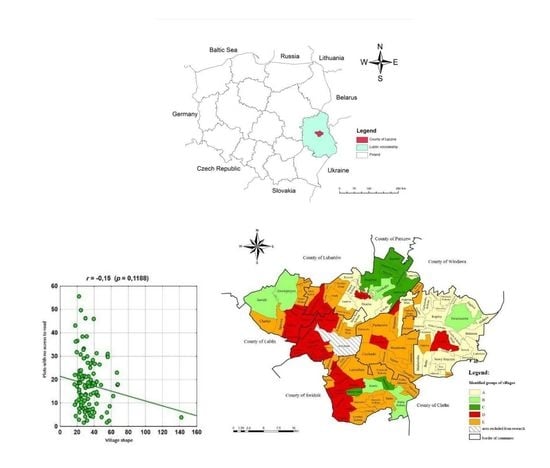Method of Delimiting the Spatial Structure of Villages for the Purposes of Land Consolidation and Exchange
Abstract
:1. Introduction
2. Materials and Methods
- (1).
- Grouping methods—used for identifying clusters of objects which are similar in terms of many of their statistical features. They are split into hierarchical and non-hierarchical ones.
- (2).
- (1).
- when p ≥0.05, we consider this to be a lack of grounds for refuting the zero hypothesis, which means that the tested difference between the groups is not statistically significant;
- (2).
- when p <0.05, we consider this to be a statistically significant difference (this fact is marked with *);
- (3).
- p <0.01 is a high significance of differences between groups (**);
- (4).
- p <0.001 is a very high significance of differences between groups (***).
3. Results and Discussion
4. Conclusions
Author Contributions
Funding
Acknowledgments
Conflicts of Interest
References
- Kostrubiec, B. Analysis of Concentrations in the Settlement Network; Wyd. PAN: Warszawa, Poland, 1972. (In Polish) [Google Scholar]
- Tkocz, J. Spatial Organisation of Villages; Publishing House of the University of Silesia: Katowice, Poland, 1998. (In Polish) [Google Scholar]
- Szmytkie, R. Methods for Analysing the Morphology and Physiognomy of Settlement Units; Scientific Papers of the Institute of Geography and Regional Development; Institute of Geography and Regional Development: Wrocław, Poland, 2014. (In Polish) [Google Scholar]
- Bentley, J.W. Economic and ecological approaches to land fragmentation: In defense of a much-maligned phenomenon. Annu. Rev. Anthropol. 1987, 16, 31–67. [Google Scholar] [CrossRef]
- Manjunatha, A.V.; Anik, A.R.; Speelman, S.; Nuppenau, E.A. Impact of land fragmentation, farm size, land ownership and crop diversity on profit and efficiency of irrigated farms in India. Land Use Policy 2013, 31, 397–405. [Google Scholar] [CrossRef]
- Van Dijk, T. Scenarios of Central European land fragmentation. Land Use Policy 2003, 20, 149–158. [Google Scholar] [CrossRef]
- Pašakarnis, G.; Maliene, V. Towards sustainable rural development in Central and Eastern Europe: Applying land consolidation. Land Use Policy 2010, 27, 545–549. [Google Scholar] [CrossRef]
- Guo, B.; Jin, X.; Yang, X.; Guan, X.; Lin, Y.; Zhou, Y. Determining the effects of land consolidation on the multifunctionality of the cropland production system in China using a SPA-fuzzy assessment model. Eur. J. Agron. 2015, 63, 12–26. [Google Scholar] [CrossRef]
- Demetriou, D. The Development of an Integrated Planning and Decision Support System (IPDSS) for Land Consolidation; Springer Science and Business Media: Berlin, Germany, 2013. [Google Scholar]
- Di Falco, S.; Penov, I.; Aleksiev, A.; van Rensburg, T. Agrobiodiversity, farm profits and land fragmentation: Evidence from Bulgaria. Land Use Policy 2010, 27, 763–771. [Google Scholar] [CrossRef]
- Cay, T.; Ayten, T.; Iscan, F. Effects of different land reallocation models on the success of land consolidation projects: Social and economic approaches. Land Use Policy 2010, 2, 262–269. [Google Scholar] [CrossRef]
- Gonzalez, X.P.; Alvarez, C.J.; Crecente, R. Evaluation of land distributions with joint regard to plot size and shape. Agric. Syst. 2004, 82, 31–43. [Google Scholar] [CrossRef]
- Gonzalez, X.P.; Marey, M.F.; Alvarez, C.J. Evaluation of productive rural land patterns with joint regard to the size, shape and dispersion of plots. Agric. Syst. 2007, 92, 52–62. [Google Scholar] [CrossRef]
- Sklenicka, P.; Janovska, V.; Salek, M.; Vlasak, J.; Molnarova, K. The Farmland Rental Paradox: Extreme land ownership fragmentation as a new form of land degradation. Land Use Policy 2014, 38, 587–593. [Google Scholar] [CrossRef]
- Cegielska, K.; Noszczyk, T.; Kukulska, A.; Szylar, M.; Hernik, J.; Dixon-Gough, R.; Jombach, S.; Valanszki, I.; Kovacs, K.F. Land use and land cover changes in post-socialist countries: Some observations from Hungary and Poland. Land Use Policy 2018, 78, 1–18. [Google Scholar] [CrossRef]
- Janus, J. Measuring land fragmentation considering the shape of transportation network: A method to increase the accuracy of modelling the spatial structure of agriculture with a case study in Poland. Comput. Electron. Agric. 2018, 148, 259–271. [Google Scholar] [CrossRef]
- Stańczuk-Gałwiaczek, M.; Sobolewska-Mikulska, K.; Ritzema, H.; van Loon-Steensma Jantsje, M. Integration of water management and land consolidation in rural areas to adapt to climate change: Experiences from Poland and the Netherlands. Land Use Policy 2018, 77, 498–511. [Google Scholar] [CrossRef]
- Ciaian, P.; Guri, F.; Rajcaniova, M.; Drabik, D.; y Paloma, S.G. Land fragmentation and production diversification: A case study from rural Albania. Land Use Policy 2018, 76, 589–599. [Google Scholar] [CrossRef]
- Noga, K. Analysis of the Intervillage Plot Patchwork on the Example of Villages Situated in the Upstream Catchment of the River Soła; Scien. Sess. 7. Issue 7. Scien. Booklets No. 133; University of Agriculture: Kraków, Poland, 1977; pp. 154–170. (In Polish) [Google Scholar]
- Noga, K.; Król, Ż. The Patchwork of Land as a Problem Restricting the Development of Rural Areas. Barom. Reg. 2016, 14, 165–173. [Google Scholar]
- Król, Ż.; Leń, P. Individual plot patchwork determination of the urgency in realization consolidation and exchange of land. Infrastruct. Ecol. Rural Areas 2016, 2016, 311–322. [Google Scholar]
- Leń, P. The ranking destination areas for land consolidation works, due to the size checkerboard land on the example of Białaczów. In Proceedings of the “Environmental Engineering” 10th International Conference Vilnius Gediminas Technical University Article, Vilnius, Lithuania, 27–28 April 2017. [Google Scholar]
- Leń, P. The size of the external patchwork of fields as an indicator of the need for land consolidation and exchange in the villages of the commune of Drzewica. J. Water Land Dev. 2017, 33, 99–106. [Google Scholar] [CrossRef]
- Hudecova, L.; Geisse, R.; Gasincova, S.; Bajtala, M. Quantification of Land Fragmentation in Slovakia. Geod. List 2017, 4, 327–388. [Google Scholar]
- Moravcova, J.; Koupilova, M.; Pavliček, T.; Zemek, F.; Kvitek, T.; Pečenka, J. Analysis of land consolidation projects and their impact on land use change, landscape structure, and agricultural land resource protection: Case studies of Pilsen-South and Pilsen-North (Czech Republic). Landsc. Ecol. Eng. 2017, 13, 1–13. [Google Scholar] [CrossRef]
- Hong Ch Jin, X.; Ren, J.; Gu, Z.; Zhou, Y. Satellite data indicates multidimensional variation of agricultural production in land consolidation area. Sci. Total Environ. 2019, 653, 735–747. [Google Scholar] [CrossRef]
- Hiironen, J.; Riekkinen, K. Agricultural impacts and profitability of land consolidations. Land Use Policy 2016, 55, 309–317. [Google Scholar] [CrossRef]
- Asiama, K.O.; Bennett, R.M.; Zevenbergen, J.A.; Da Silva Mano, A. Responsible consolidation of customary lands: A framework for land reallocation. Land Use Policy 2019, 83, 412–423. [Google Scholar] [CrossRef] [Green Version]
- FAO. Opportunities to Mainstream Land Consolidation in Rural Development Programmes of the European Union; FAO-Land Tenure Policy Series; FAO: Rome, Italy, 2008. [Google Scholar]
- Johansen, P.H.; Ejrnæs, R.; Kronvang, B.; Vesterlund Olsen, J.; Præstholm, S.; Schou, J. Pursuing collective impact: A novel indicator-based approach to assessment of shared measurements when planning for multifunctional land consolidation. Land Use Policy 2018, 73, 102–114. [Google Scholar] [CrossRef]
- Janus, J.; Taszakowski, J. Spatial differentiation of indicators presenting selected barriers in the productivity of agricultural areas: A regional approach to setting land consolidation priorities. Ecol. Indic. 2018, 93, 718–729. [Google Scholar] [CrossRef]
- Stanik, N.; Aalders, I.; Miller, D. Towards an indicator-based assessment of cultural heritage as a cultural ecosystem service―A case study of Scottish landscapes. Ecol. Indic. 2018, 95, 288–297. [Google Scholar] [CrossRef]
- Xiao, W.; Mills, J.; Guidi, G.; Rodrigez-Gonzalvez, P.; Gonizzi Barsanti, S.; Gonzalez-Aguilera, D. Geoinformatics for the conservation and promotion of cultural heritage in support of the UN Sustainable Development Goals. ISPRS J. Photogramm. Remote Sens. 2018, 142, 389–406. [Google Scholar] [CrossRef]
- Sobolewska-Mikulska, K. (Ed.) Contemporary Consolidation of Land in Shaping the Limits of Agricultural Production Space; Publishing House of the Technical University of Warsaw: Warsaw, Poland, 2009. [Google Scholar]
- Mika, M. Interoperability cadastral data in the system approach. J. Ecol. Eng. 2017, 18, 150–156. [Google Scholar] [CrossRef]
- Mika, M. Proposals for changes in surveying-legal procedures for the needs of cadastre in Poland. Rep. Geod. Geoinform. 2016, 102, 67–77. [Google Scholar] [CrossRef]
- Mika, M.; Siejka, M.; Leń, P.; Król, Ż. The concept of using the water cadastre databases components for the construction of multi-dimensional cadastre in Poland. Surv. Rev. 2018, 50, 201–211. [Google Scholar] [CrossRef]
- Dawidowicz, A.; Źrobek, R. Analysis of concepts of cadastral system technological development. Procedia Engineering. In Proceedings of the 9th International Conference “Environmental Engineering”, Vilnius Gediminas Technical University, Vilnius, Lithuania, 22 May–23 May 2014. [Google Scholar] [CrossRef]
- Leń, P. An algorithm for selecting groups of factors for priorization of land consolidation in rural areas. Comput. Electron. Agric. 2018, 144, 216–221. [Google Scholar] [CrossRef]
- Postek, P. Differences in spatial structure of rural areas of commune of Goraj with regard to size of farms owned by natural persons. In Proceedings of the 17th International Scientific Conference Engineering for Rural Development, Jelgava, Latvia, 23–25 May 2018; pp. 605–610. [Google Scholar] [CrossRef]
- Tomic, H.; Mastelic Ivic, S.; Roić, M. Land Consolidation Suitability Ranking of Cadastral Municipalities: Information-Based Decision-Making Using Multi-Criteria Analyses of Official Registers’ Data. Int. J. Geo-Inform. 2018, 7, 87. [Google Scholar] [CrossRef]
- Noga, K. Methods of Consolidation Works Programming and Their Performance Technology in Mountainous Areas (Using the Example of the Catchment of the Soła River in the Beskid Mountains); Scientific Papers, Dissertations Series, No. 143; University of Agriculture: Kraków, Poland, 1990. (In Polish) [Google Scholar]
- Noga, K. Methodology of Programming and Implementation of Consolidation and Exchange of Land Works in the Complex Formulation; Szkoła wiedzy o Terenie: Kraków, Poland, 2001. (In Polish) [Google Scholar]
- Noga, K. Topology of Mountain Villages for the Needs of Rural Management Works. Land Surveying; Scientific Papers No. 155; University of Agriculture: Kraków, Poland, 1979; Volume 6, pp. 17–29. (In Polish) [Google Scholar]
- Leń, P. The Method for Determining the Urgency of Needs for Land Consolidation and Exchange. Ph.D. Dissertation, AGH University of Science and Technology in Kraków, Kraków, Poland, 2013. (In Polish). [Google Scholar]
- Leń, P.; Oleniacz, G.; Skrzypczak, I.; Mika, M. The Hellwig’s and zero unitarisation methods in creating a ranking of the urgency of land consolidation and land exchange work. In Proceedings of the 16th International Multidisciplinary Scientific GeoConference SGEM 2016, Albena, Bulgaria, 30 June–6 July 2016; Volume 2, pp. 617–624. [Google Scholar]
- Domański, S. Typological procedure in economic and agricultural surveys. Geogr. Rev. 1969, XVI Pt 1, 55–68. (In Polish) [Google Scholar]
- Fajferek, A. Economic Region and Methods of Regional Analysis; “ZN WSE Kraków”, Dissertations Series No. 6; Poland, 1964. (In Polish) [Google Scholar]
- Król, B. Taxonomic Method of Smallest Differences Applied in Classification of Farms; Scientific Papers of the School of Agriculture in Kraków, Series Economics; University of Agriculture: Kraków, Poland, 1969; Part 5. (In Polish) [Google Scholar]
- Liczkowski, J. Delimitation of agricultural intensity regions using the average differences method. Agric. Econ. Issues 1972, 2. (In Polish) [Google Scholar]
- Steczkowski, J. Principles and Methods of Identifying Agricultural Production Regions; PWRiL: Warsaw, Poland, 1966. (In Polish) [Google Scholar]
- Noga, K. Method of Grouping the Spatial Structure of Mountain Villages; Land Surveying Vol. 10, Scientific Papers 1988. No. 221; University of Agriculture: Kraków, Poland, 1998. (In Polish) [Google Scholar]
- Ernst, E. Geographical and agricultural regions of Poland. Geogr. J. 1934, 10. (In Polish) [Google Scholar]
- Fierich, J. Attempted application of taxonomic methods for the purposes of identifying agricultural system regions in Kraków voivodeship. Econo. Thought 1957, 3. (In Polish) [Google Scholar]
- Filip, T.; Steczkowski, J. Attempted application of spatial differences for the purposes of identifying agricultural production regions in Rzeszów voivodeship. Econ. Issues 1962, 5. (In Polish) [Google Scholar]
- Hopfer, A. Method for determining territorial maturity of agricultural management units for change in the structure of their area. ZN ART. In Olsztyn 1974, 3. (In Polish) [Google Scholar]
- The Rural Development Program. Available online: https://www.gov.pl/documents/912055/913531/Program_Rozwoju_Obszar%C3%B3w_Wiejskich_na_lata_2014-2020.pdf/0775b248-4719-35df-c44b-e81ffe4e977a (accessed on 4 March 2019).
- Wójcik-Leń, J.; Sobolewska-Mikulska, K.; Sajnóg, N.; Leń, P. The idea of rational management of problematic agricultural areas in the course of land consolidation. Land Use Policy 2018, 78, 36–45. [Google Scholar] [CrossRef]
- Madsen, L.M.; Adriansen, H.K. Understanding the use of rural space: The need for multi-methods. J. Rural Stud. 2004, 20, 485–497. [Google Scholar] [CrossRef]
- The Development Strategy of the Łęczna County for the Years 2016–2021. Available online: http://powiatleczynski.pl/strony,show,5038,strategia-rozwoju-powiatu-leczynskiego-na-lata-20162021.html (accessed on 4 March 2019).
- Matkowska, K. Land Valuation Methods for the Needs of Comprehensive Consolidation Works. Ph.D. Dissertation, Hugon Kołłątaj University of Agriculture in Kraków, Kraków, Poland, 2016. (In Polish). [Google Scholar]
- Grabiński, T.; Sokołowski, A. From Studies on the Efficiency of Selected Taxonomic Procedures; Scientific Papers of the University of Agriculture in Kraków, No. 181; 1984. (In Polish) [Google Scholar]
- Ostasiewicz, W. (Ed.) Statistical Methods of Data Analysis; Publishing House of the Economic University in Wrocław: Wrocław, Poland, 1999. (In Polish) [Google Scholar]
- Hydzik, P.; Sobolewski, M. Computer-Aided Analysis of Social and Economic Data; Publishing House of the Technical University of Rzeszów: Rzeszów, Poland, 2007. (In Polish) [Google Scholar]
- Hellwig, Z. Multidimensional comparative analysis and its applications in multi-feature studies of economic objects. In Economic and Mathematical Methods and Models in Improvement of Socialist Economy Management; Welfe, W., Ed.; PWE: Warsaw, Poland, 1981. (In Polish) [Google Scholar]
- Heffner, K.; Gibas, P. Economic and Spatial Analysis; Publishing House of the Economic University in Katowice: Katowice, Poland, 2007. (In Polish) [Google Scholar]
- Młynarczyk, W. Taxonomic Methods in Spatial Studies in Agriculture; KPZK; PAN: Poland, 1970; Volume 61. (In Polish) [Google Scholar]
- Kozłowski, S. On the method of verification of spatial divisions with reference to the taxonomic method of differences by J. Czekanowski. Stat. News 1972, 1. (In Polish) [Google Scholar]



| No. | Groups of Study Variables | Number | % |
|---|---|---|---|
| 1. | Structure of land ownership | 7 | 17.1 |
| 2. | Structure of agricultural land | 12 | 29.3 |
| 3. | Productivity of cropland | 3 | 7.3 |
| 4. | Fragmentation of agricultural real property and plots | 8 | 19.5 |
| 5. | Distribution of agricultural real property and plots | 9 | 22.0 |
| 6. | Plot shape and access parameters | 2 | 4.9 |
| Total | 41 | 100.0 | |
| No. | Groups of Variables | The Abbreviation for the Variable | The Variable in Full |
|---|---|---|---|
| 1 | The structure of land ownership | x1 | % of the area of private land |
| x2 | % of land owned by the Agricultural Property Agency of the State Treasury | ||
| x3 | % of land owned by the State Forests National Forest Holding | ||
| x4 | % of land of the State Treasury subject to perpetual usufruct | ||
| x5 | % of the area of land owned by communes and their unions | ||
| x6 | % of the area of land owned by counties and their unions | ||
| x7 | % of the area of land owned by voivodeships | ||
| 2 | The structure of agricultural land | x8 | % of cropland (in the village) |
| x9 | % of orchards | ||
| x10 | % of meadows | ||
| x11 | % of pastures | ||
| x12 | % of built-up agricultural land | ||
| x13 | % of built-up land | ||
| x14 | % of water bodies (still) | ||
| x15 | % of forestland | ||
| x16 | % of land with tree stands and shrubs | ||
| x17 | % of roads | ||
| x18 | % of water courses | ||
| x19 | % share of wasteland | ||
| 3 | The productivity of cropland, meadows and pastures | x20 | productivity index for cropland |
| x21 | productivity index for meadows | ||
| x22 | productivity index for pastures | ||
| 4 | Fragmentation of agricultural real property and plots | x23 | % of the number of plots up to 0.10 ha |
| x24 | % of 0.11–0.30 ha plots | ||
| x25 | % of 0.31–0.60 ha plots | ||
| x26 | % of 0.61–0.90 ha plots | ||
| x27 | % of 0.91–1.20 ha plots | ||
| x28 | % of 1.21–1.50 ha plots | ||
| x29 | % of 1.51–1.80 ha plots | ||
| x30 | % of the number of plots with the area exceeding 1.81 | ||
| 5 | Distribution of agricultural real property and plots | x31 | % of plots of local non-resident owners in relation to the number of private plots in the village |
| x32 | average area of a plot of a local non-resident owner | ||
| x33 | % of plots of local non-resident owners in relation to the area of private land in the village | ||
| x34 | % of plots of out-of-village non-resident owners in relation to the number of private plots in the village | ||
| x35 | average area of a plot of an out-of-village non-resident owner | ||
| x36 | % of the number of out-of-village non-resident owners from cities | ||
| x37 | % of area of out-of-village non-resident owners in relation to the area of private land | ||
| x38 | % of the number of local non-resident owners in relation to the number of registered residents of the village | ||
| x39 | % of the number of out-of-village non-resident owners in relation to the number of registered residents of the village | ||
| 6 | shape parameters of plots and their accessibility by road | x40 | ratio of plots without access to roads |
| x41 | village shape ratio |
| Subsequent Principal Component | Own Value | Percentage of Variation | Accumulated Own Value | Accumulated Percentage of Variation |
|---|---|---|---|---|
| 1 | 453.4 | 70.5% | 453.4 | 70.5% |
| 2 | 118.6 | 18.4% | 572.0 | 88.9% |
| Structure of Agricultural Land (% Share) | Inputs for the Variable | Correlations of Variables | ||
|---|---|---|---|---|
| Factor 1 | Factor 2 | Factor 1 | Factor 2 | |
| cropland | 74.1% | 4.4% | −0.99 | −0.12 |
| orchards | 0.1% | 0.0% | −0.41 | −0.07 |
| meadows | 6.3% | 34.1% | 0.59 | 0.71 |
| pastures | 0.1% | 1.2% | 0.14 | 0.32 |
| farm buildings | 0.1% | 0.0% | −0.62 | −0.06 |
| buildings | 0.0% | 0.0% | −0.00 | −0.01 |
| still waters | 0.3% | 0.4% | 0.25 | 0.15 |
| forestland | 18.8% | 59.6% | 0.73 | −0.67 |
| tree stands and shrubs | 0.0% | 0.0% | 0.18 | 0.08 |
| roads | 0.0% | 0.0% | −0.06 | 0.23 |
| water courses | 0.0% | 0.0% | 0.22 | 0.16 |
| wasteland | 0.0% | 0.3% | 0.18 | 0.27 |
| Group of Villages | Number of Villages | Total Area of the Village | ||
|---|---|---|---|---|
| Number | % | ha | % | |
| A | 31 | 26.7 | 15646.70 | 25.3 |
| B | 6 | 5.2 | 8196.47 | 13.3 |
| C | 8 | 6.9 | 4958.63 | 8.0 |
| D | 31 | 26.7 | 11726.8 | 19.0 |
| E | 40 | 34.5 | 21208.8 | 34.4 |
| In total: | 116 | 100.0 | 61737.38 | 100.0 |
| Percentage of Area According to Ownership | Group | P | ||||
|---|---|---|---|---|---|---|
| A | B | C | D | E | ||
| Private land | 85.1 | 48.0 | 72.2 | 94.8 | 85.3 | 0.0000 *** |
| Land of the Agricultural Property Agency of the State Treasury | 3.9 | 1.9 | 2.1 | 0.4 | 4.3 | 0.0000 *** |
| State Forests National Forest Holding | 1.8 | 45.5 | 10.5 | 0.6 | 1.7 | 0.0000 *** |
| Land of the State Treasury under perpetual usufruct | 0.2 | 0.1 | 2.8 | 0.4 | 1.5 | 0.0030 ** |
| Land owned by communes and their unions | 2.1 | 1.1 | 3.7 | 1.3 | 2.0 | 0.0052 ** |
| Land owned by counties and their unions | 0.6 | 0.7 | 0.6 | 0.8 | 0.7 | 0.9623 |
| Land owned by voivodeships | 0.1 | 0.0 | 0.2 | 0.3 | 0.2 | 0.4799 |
© 2019 by the authors. Licensee MDPI, Basel, Switzerland. This article is an open access article distributed under the terms and conditions of the Creative Commons Attribution (CC BY) license (http://creativecommons.org/licenses/by/4.0/).
Share and Cite
Stręk, Ż.; Noga, K. Method of Delimiting the Spatial Structure of Villages for the Purposes of Land Consolidation and Exchange. Remote Sens. 2019, 11, 1268. https://doi.org/10.3390/rs11111268
Stręk Ż, Noga K. Method of Delimiting the Spatial Structure of Villages for the Purposes of Land Consolidation and Exchange. Remote Sensing. 2019; 11(11):1268. https://doi.org/10.3390/rs11111268
Chicago/Turabian StyleStręk, Żanna, and Karol Noga. 2019. "Method of Delimiting the Spatial Structure of Villages for the Purposes of Land Consolidation and Exchange" Remote Sensing 11, no. 11: 1268. https://doi.org/10.3390/rs11111268
APA StyleStręk, Ż., & Noga, K. (2019). Method of Delimiting the Spatial Structure of Villages for the Purposes of Land Consolidation and Exchange. Remote Sensing, 11(11), 1268. https://doi.org/10.3390/rs11111268






